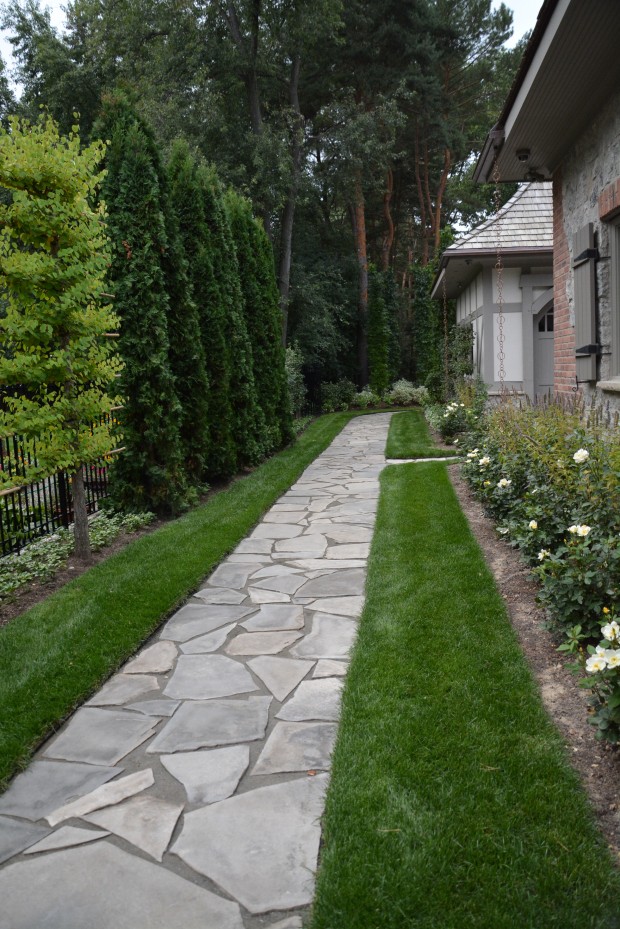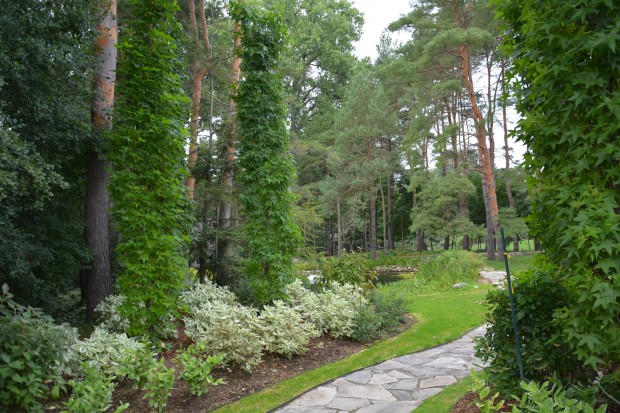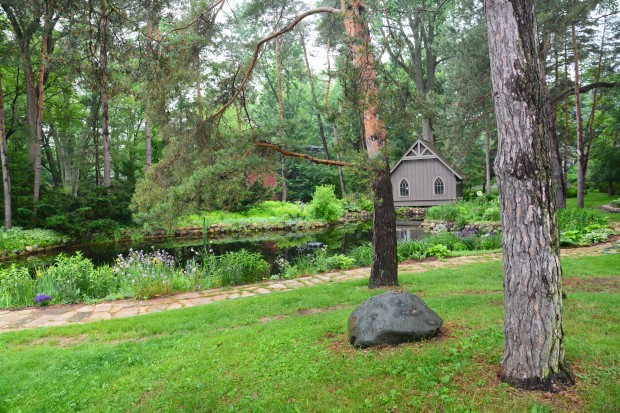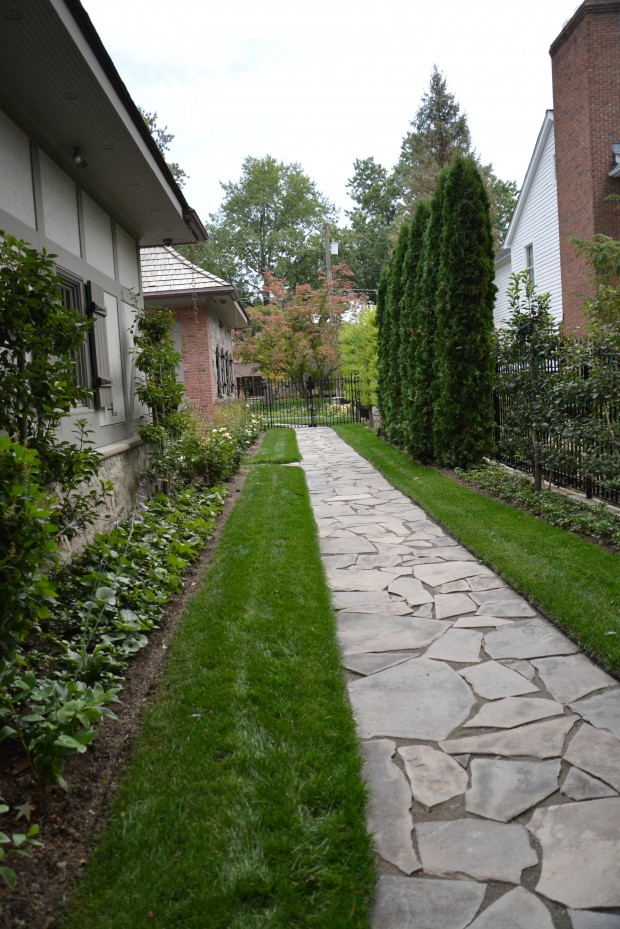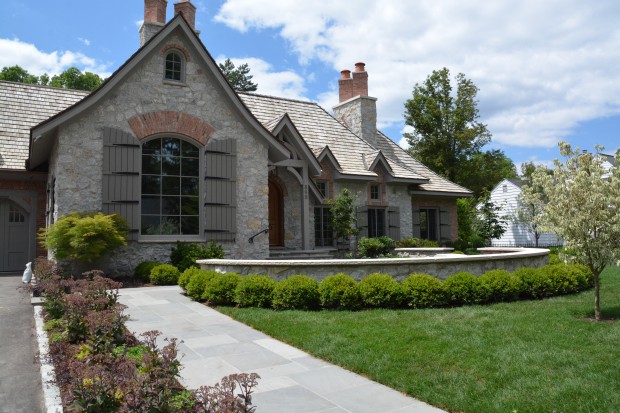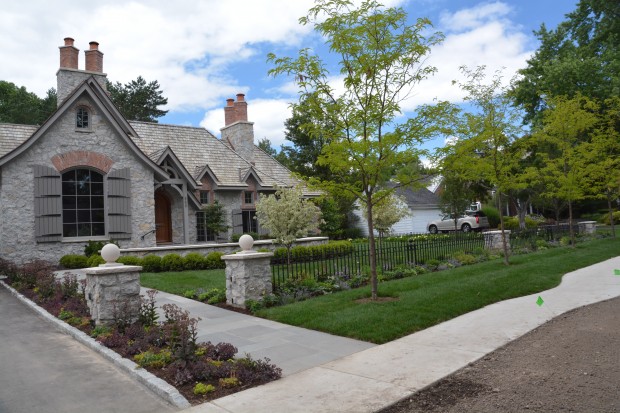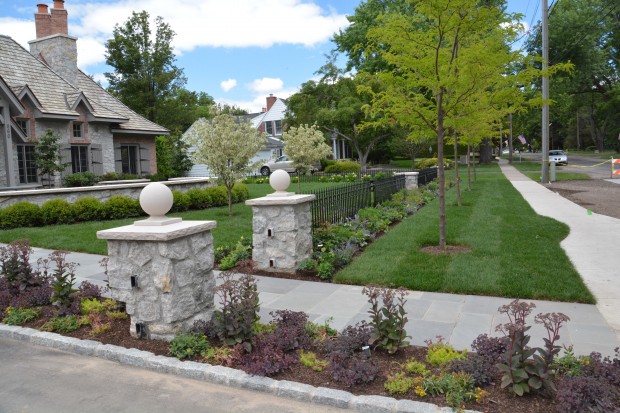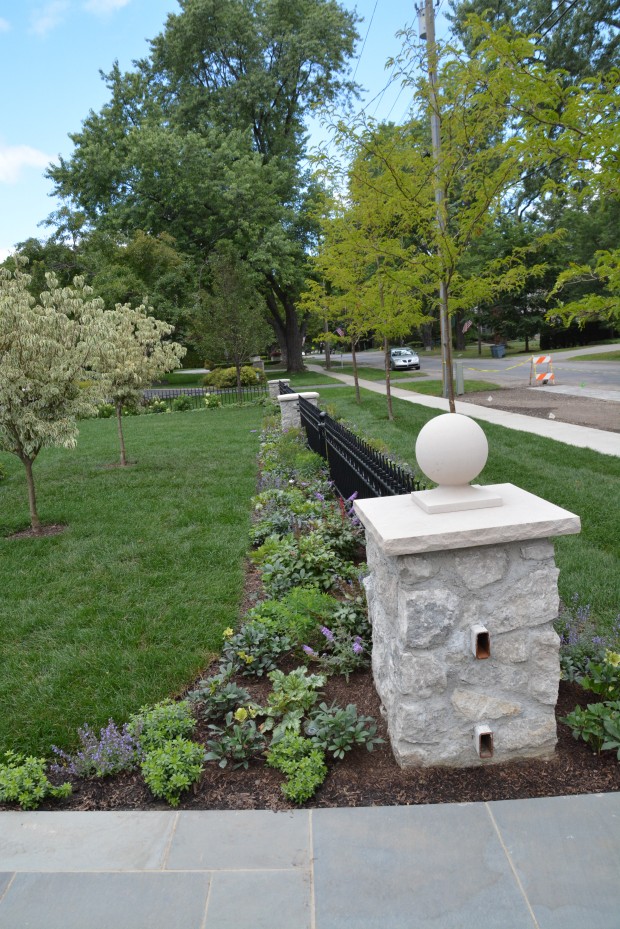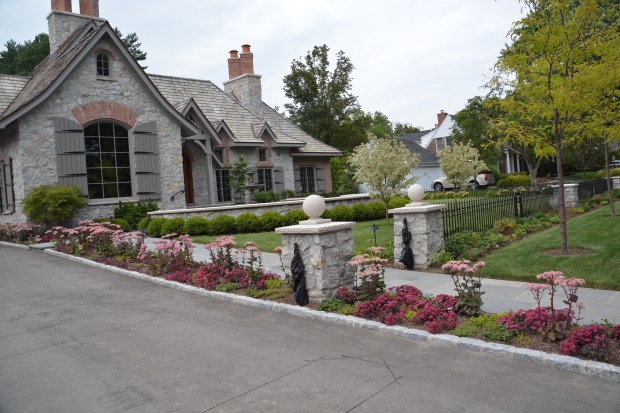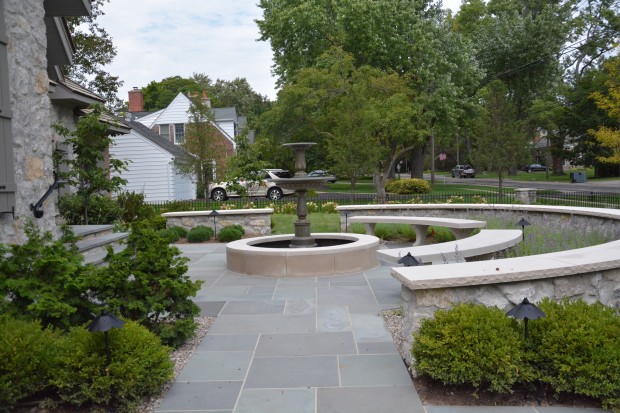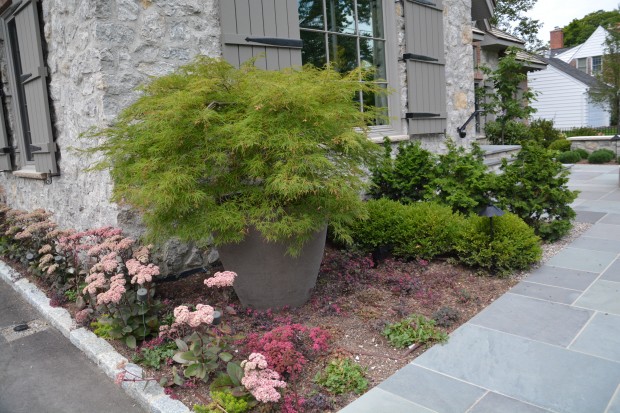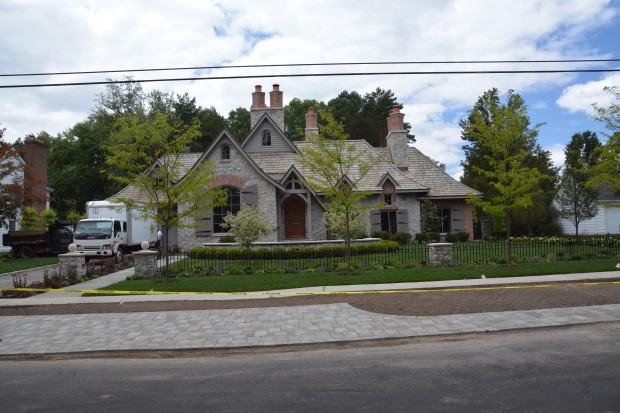Archives for 2014
A Landscape For A Gardener: Part 4: The Finish
A Landscape For A Gardener: The Plants
 The focus of the landscape in the rear yard was and still is the pond. The informally planted pond gardens, surrounded by old scotch pines and punctuated by a small barn, look and feel as though they have reached a mature state of natural equilibrium. I am not fooled. A devoted gardener created this garden, and spends lots of time and effort caring for it. The new garden pictured above occupies the mid ground space, which separates the formal pool deck from the sprawling pond landscape. Since this garden will primarily be viewed from above, a collection of equally small growing perennials will feature the flowers, framed by foliage.
The focus of the landscape in the rear yard was and still is the pond. The informally planted pond gardens, surrounded by old scotch pines and punctuated by a small barn, look and feel as though they have reached a mature state of natural equilibrium. I am not fooled. A devoted gardener created this garden, and spends lots of time and effort caring for it. The new garden pictured above occupies the mid ground space, which separates the formal pool deck from the sprawling pond landscape. Since this garden will primarily be viewed from above, a collection of equally small growing perennials will feature the flowers, framed by foliage.
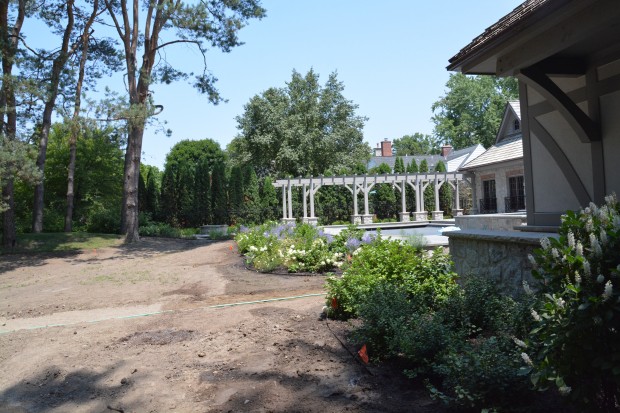 The arrangement of the different varieties is informal and random. The modest height of the plants will not obstruct the view to the pond. The bed is anchored by the dwarf white hydrangea, “Bombshell. The firepit garden includes hemerocallis “Citron”, an Al Goldner variety, and amsonia heubrechtii. The bed on the near side of the stone walk from the pool deck to the pond (not yet installed) is planted with small growing shrubs- spirea “Tor”, rhus aromatica “Gro-Low”, and clethra Ruby Spice.
The arrangement of the different varieties is informal and random. The modest height of the plants will not obstruct the view to the pond. The bed is anchored by the dwarf white hydrangea, “Bombshell. The firepit garden includes hemerocallis “Citron”, an Al Goldner variety, and amsonia heubrechtii. The bed on the near side of the stone walk from the pool deck to the pond (not yet installed) is planted with small growing shrubs- spirea “Tor”, rhus aromatica “Gro-Low”, and clethra Ruby Spice.
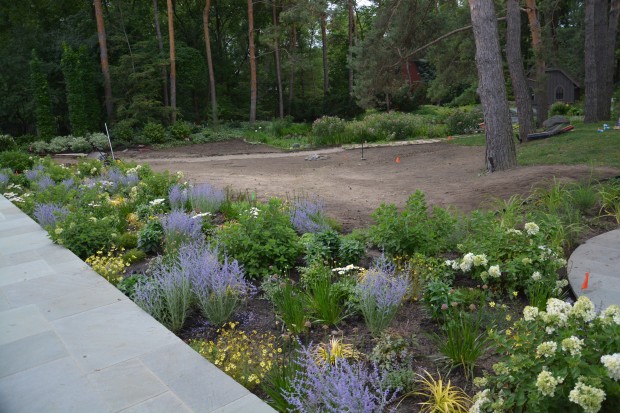
Perennial cultivars include alchemilla mollis, astilbe “Fanal”, Buddleia “Lilac Chip”, Leucanthemum “Snowcap”, Coreopsis “Moonbeam, perovskia “Peek-a-Boo”, Geranium “Tiny Monster”, Carex “Emerillo”, lavender and blue moss phlox, allium “Millenium”, nepeta “Persian Blue” and monarda “Grand Parade”.
 Turning the corner from the south side garden to the rear yard, a group of columnar liquidambar “Slender Silhouette” frames the view to come. Viburnum “Shasta”, viburnum “Mohican”, aesculus parviflora, and variegated red twig dogwood are underplanted with variegated solomon’s seal, and epimedium “Frohn Leiten”.
Turning the corner from the south side garden to the rear yard, a group of columnar liquidambar “Slender Silhouette” frames the view to come. Viburnum “Shasta”, viburnum “Mohican”, aesculus parviflora, and variegated red twig dogwood are underplanted with variegated solomon’s seal, and epimedium “Frohn Leiten”.
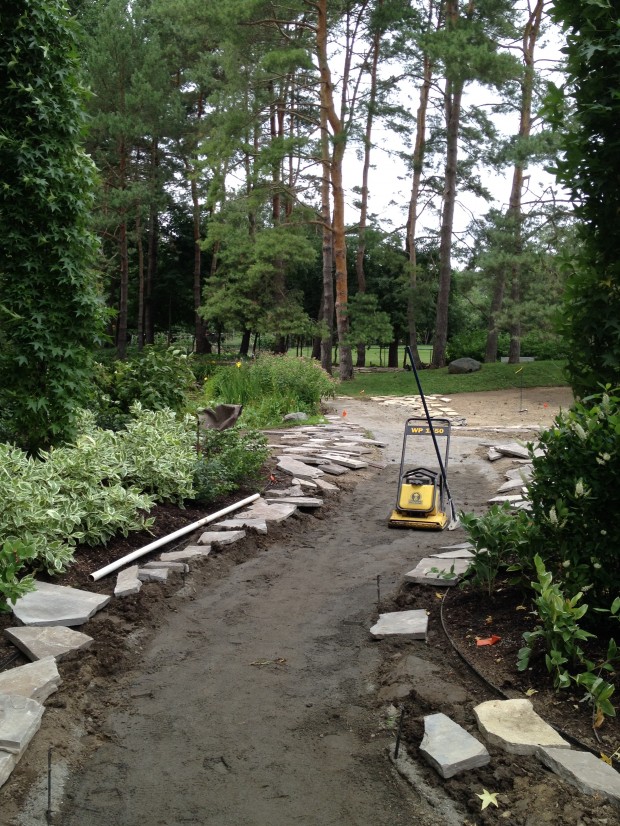 The columnar sweet gum is a great choice for a tree of substance that will grow comfortably in a small and narrow space. The informally growing shrubs bring the pond garden to the foreground, and smooth the visual transition from the more formal house gardens towards the pond.
The columnar sweet gum is a great choice for a tree of substance that will grow comfortably in a small and narrow space. The informally growing shrubs bring the pond garden to the foreground, and smooth the visual transition from the more formal house gardens towards the pond.
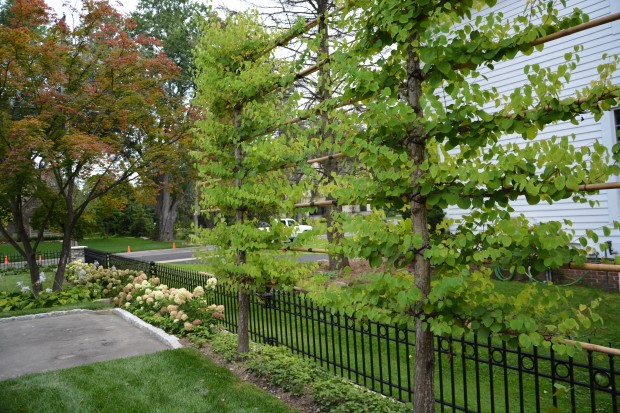 The landscape has 12 espaliered trees. 8 katsuras provide a lot of screening on both the north and south lot lines without taking up much in the way of space. These espaliers will be grown into and maintained as a solid green wall. The north and south perimeter of the front yard landscape is planted with hydrangea “Little Lime”. Small properties ask for plant material small and narrow in scale. A pair of old silver maples in the tree lawn had to be removed. Giant girdling roots eventually did them in. We replaced the street trees with honey locusts. Though they fill the bill as street trees, their canopy is open growing, and their roots are friendly to the well being of companion plants.
The landscape has 12 espaliered trees. 8 katsuras provide a lot of screening on both the north and south lot lines without taking up much in the way of space. These espaliers will be grown into and maintained as a solid green wall. The north and south perimeter of the front yard landscape is planted with hydrangea “Little Lime”. Small properties ask for plant material small and narrow in scale. A pair of old silver maples in the tree lawn had to be removed. Giant girdling roots eventually did them in. We replaced the street trees with honey locusts. Though they fill the bill as street trees, their canopy is open growing, and their roots are friendly to the well being of companion plants.
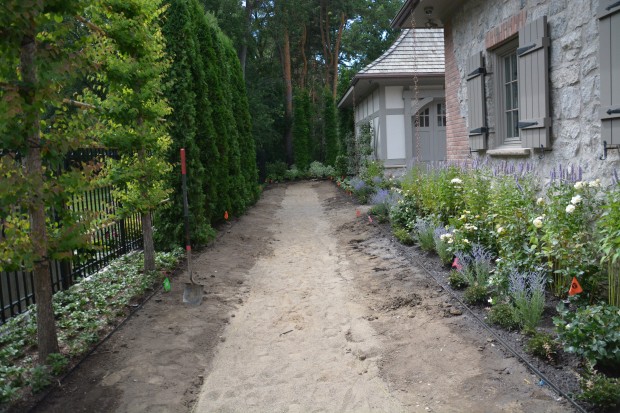 The south side garden includes fruiting pear trees, and a run of arborvitae, planted for privacy. The garden includes Macy’s Pride rose, Sunny knockout rose, hyssop, astilbe “Sprite, and the dwarf Russian sage, “Peek-a-Boo”. Towards the rear, the pear espaliers are underplanted with brunnera “Jack Frost”, and pachysandra.
The south side garden includes fruiting pear trees, and a run of arborvitae, planted for privacy. The garden includes Macy’s Pride rose, Sunny knockout rose, hyssop, astilbe “Sprite, and the dwarf Russian sage, “Peek-a-Boo”. Towards the rear, the pear espaliers are underplanted with brunnera “Jack Frost”, and pachysandra.
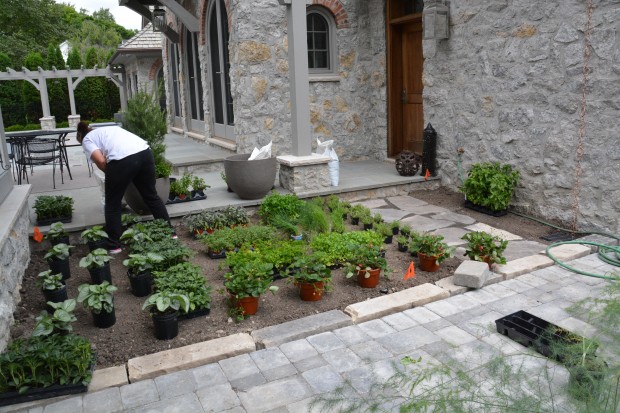 The brunnera wraps around the side, where the garden is shaded by an overhang. The sunnier areas are planted with herbs, both perennial and annual. Pots were added at the last for tomatoes, and flowers.
The brunnera wraps around the side, where the garden is shaded by an overhang. The sunnier areas are planted with herbs, both perennial and annual. Pots were added at the last for tomatoes, and flowers.
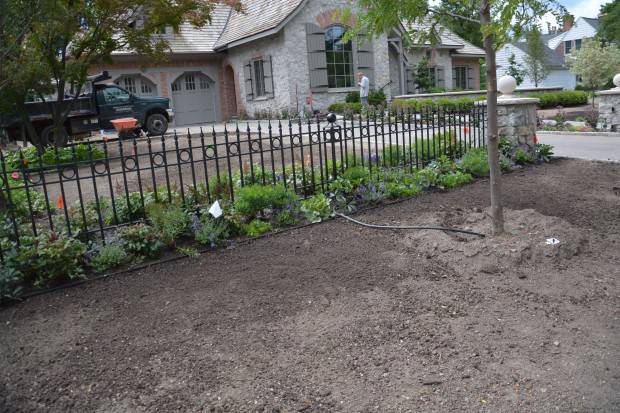 In the front yard, a garden was planned for both sides of the iron fence. Given the low height of the fence, the perennials are correspondingly short. The garden is anchored with a number of helleborus “Jacob”. Added to this, more dwarf buddleia, anemone “Snowdrop”, sweet woodriff, aster “Wood’s Blue”, Salvia “Marcus, heuchera “Venus”and Euphorbia polychroma. This garden will be planted with small spring flowering bulbs this coming month.
In the front yard, a garden was planned for both sides of the iron fence. Given the low height of the fence, the perennials are correspondingly short. The garden is anchored with a number of helleborus “Jacob”. Added to this, more dwarf buddleia, anemone “Snowdrop”, sweet woodriff, aster “Wood’s Blue”, Salvia “Marcus, heuchera “Venus”and Euphorbia polychroma. This garden will be planted with small spring flowering bulbs this coming month.
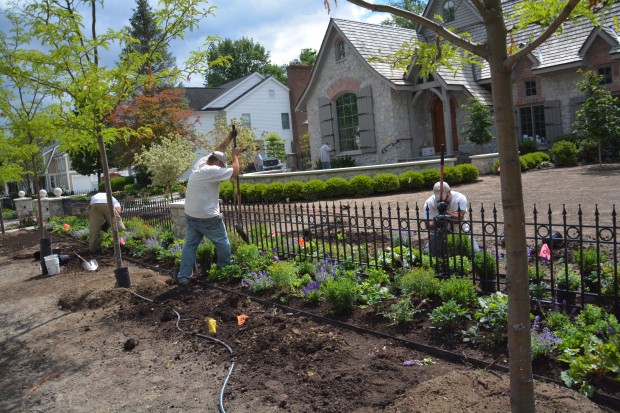 The fence actually follows the line set by the sidewalk, which is not parallel to the house. This width of the garden on either side of the fence varies depending on the location. This helps to create the impression that the fence runs parallel to the house. Why would I think this was important? This space is more formally designed. I am usually reluctant to plant perennial gardens in a front yard. If I do plant them there, I like the effect to be compact and tailored-not a look that nature is particularly inclined to. Perennial gardens only look as good as the quality of the maintenance devoted to them. But this client loves, and looks after her gardens.
The fence actually follows the line set by the sidewalk, which is not parallel to the house. This width of the garden on either side of the fence varies depending on the location. This helps to create the impression that the fence runs parallel to the house. Why would I think this was important? This space is more formally designed. I am usually reluctant to plant perennial gardens in a front yard. If I do plant them there, I like the effect to be compact and tailored-not a look that nature is particularly inclined to. Perennial gardens only look as good as the quality of the maintenance devoted to them. But this client loves, and looks after her gardens.
 This garden also solves the issue of how the fence interacts with the landscape. Mulch or stone under the fence-rather bleak. Grass up to the fence is very difficult to maintain in a beautiful way. This fence is an architectural feature of the yard-the garden says so.
This garden also solves the issue of how the fence interacts with the landscape. Mulch or stone under the fence-rather bleak. Grass up to the fence is very difficult to maintain in a beautiful way. This fence is an architectural feature of the yard-the garden says so.
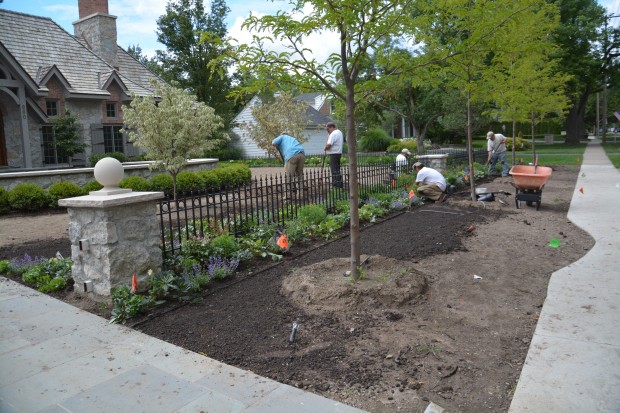 The front yard features two types of dogwoods. A pair of cornus kousa “Venus” will growing to a height of about 15 feet, and features large white flowers in June. A pair of variegated cornus kousa “Samaratin” are planted between the boxwood describing the curved stone wall, and the fence garden.
The front yard features two types of dogwoods. A pair of cornus kousa “Venus” will growing to a height of about 15 feet, and features large white flowers in June. A pair of variegated cornus kousa “Samaratin” are planted between the boxwood describing the curved stone wall, and the fence garden.
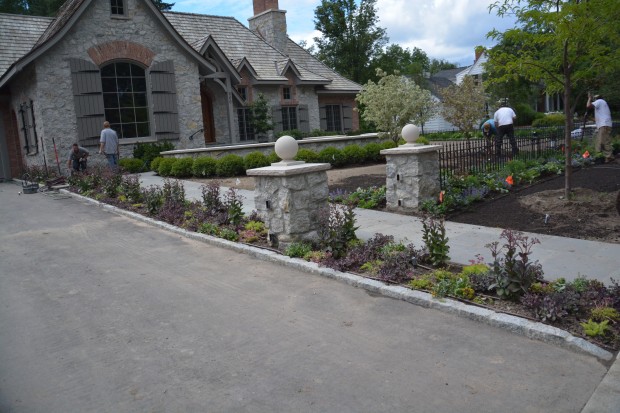 A narrow strip of a bed separates the driveway from the walk to the front door. That garden is entirely comprised of hens and chicks and sedums. Sedum Vera Jamieson, Dazzel Berry, Mr. Goodbud, John Creech, Matrona and angelina were outfitted with drip lines, so they could be watered on an appropriately infrequent schedule.
A narrow strip of a bed separates the driveway from the walk to the front door. That garden is entirely comprised of hens and chicks and sedums. Sedum Vera Jamieson, Dazzel Berry, Mr. Goodbud, John Creech, Matrona and angelina were outfitted with drip lines, so they could be watered on an appropriately infrequent schedule.
 Columnar Bradford pears on the north lot line will provide a little large scale company to the house.
Columnar Bradford pears on the north lot line will provide a little large scale company to the house.
 The garden at the front is planted with azalea “Stewartsonii, and a collection of blue leaved hostas of varying sizes. The cultivars include hosta sieboldiana elegans, krossa regal, Halcyon, Regal Splendor, and Mouse Ears. Regal splendor is a krossa regal variety with cream edges. By mt client’s special request, a few rhododendron “Nova Zembla”.
The garden at the front is planted with azalea “Stewartsonii, and a collection of blue leaved hostas of varying sizes. The cultivars include hosta sieboldiana elegans, krossa regal, Halcyon, Regal Splendor, and Mouse Ears. Regal splendor is a krossa regal variety with cream edges. By mt client’s special request, a few rhododendron “Nova Zembla”.
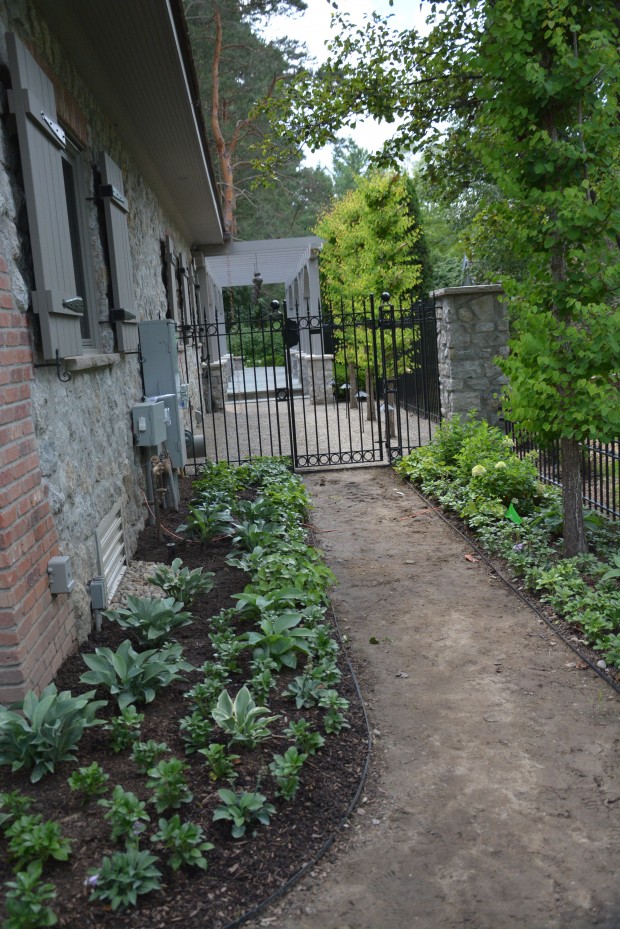 Of course the pool yard has a more serious fence and gate-this is code. But the iron work is light, and permits a glimpse through to the pool terrace pergola.
Of course the pool yard has a more serious fence and gate-this is code. But the iron work is light, and permits a glimpse through to the pool terrace pergola.
 The last of the planting? Due to the location of several underground mechanical boxes, this area could not be planted in ground. A frost proof Belgian stoneware pot would be planted with a dwarf Japanese maple. We will most likely drop-pot the maple, meaning we will drop in into the container, plastic pot and all, for the spring, summer, and fall. The maple will be stored in the garage for the winter. Once in a while I am fortunate enough to have a client who wants a landscape filled with gardens. She has a very special way with plants. This landscape will shine, given her care.
The last of the planting? Due to the location of several underground mechanical boxes, this area could not be planted in ground. A frost proof Belgian stoneware pot would be planted with a dwarf Japanese maple. We will most likely drop-pot the maple, meaning we will drop in into the container, plastic pot and all, for the spring, summer, and fall. The maple will be stored in the garage for the winter. Once in a while I am fortunate enough to have a client who wants a landscape filled with gardens. She has a very special way with plants. This landscape will shine, given her care.
A Landscape For A Gardener : Part 2: The Dirt
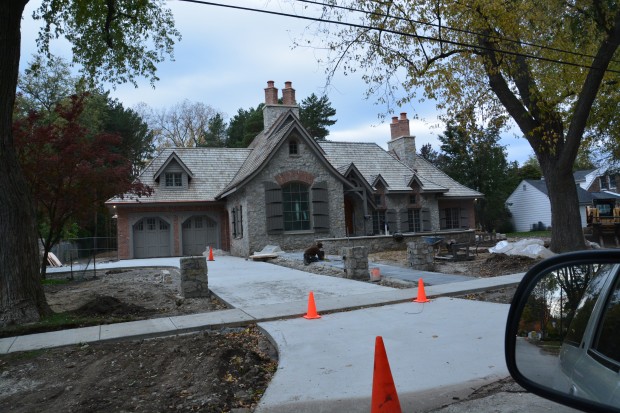 By the final months of 2013, the sidewalk was nearing completion, the driveway base got poured, the curving front courtyard wall and pillars for the cast iron fence were complete. The iron work-yet to come. At least we were past the point of contractors parking in the front yard. It is next to impossible to convey to an electrician that the weight of his vehicle damages the structure and drainage capacity of soil. We just breathe a sigh of relief when they are finished and gone. The ground that has been driven over for years had become much like a parking lot, only paved with dirt. To make matters worse, our area is noted for its heavy clay soil. This project involved lots of hand digging to reintroduce oxygen to the soil, and the addition of compost to leaven the clay.
By the final months of 2013, the sidewalk was nearing completion, the driveway base got poured, the curving front courtyard wall and pillars for the cast iron fence were complete. The iron work-yet to come. At least we were past the point of contractors parking in the front yard. It is next to impossible to convey to an electrician that the weight of his vehicle damages the structure and drainage capacity of soil. We just breathe a sigh of relief when they are finished and gone. The ground that has been driven over for years had become much like a parking lot, only paved with dirt. To make matters worse, our area is noted for its heavy clay soil. This project involved lots of hand digging to reintroduce oxygen to the soil, and the addition of compost to leaven the clay.
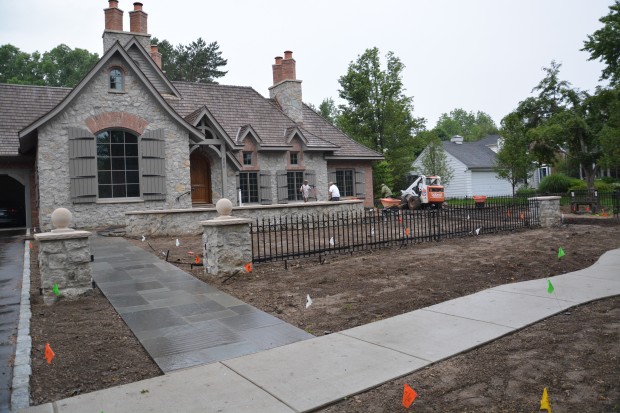 The soil would need grading to the levels established by the house, drive, walk and terraces. This part of the landscape installation takes the most time. Once the soil is graded, a good rain will tell if there are any non-draining areas. Once plants are in the ground, they cover over any water that may be sitting on top of the soil. It is vastly easier to spot drainage problems in this stage. Eventually the iron fencing got installed, all but one panel. We needed access to the yard with a machine, and tools. The new blue stone sidewalk was for foot traffic only-and certainly not our feet.
The soil would need grading to the levels established by the house, drive, walk and terraces. This part of the landscape installation takes the most time. Once the soil is graded, a good rain will tell if there are any non-draining areas. Once plants are in the ground, they cover over any water that may be sitting on top of the soil. It is vastly easier to spot drainage problems in this stage. Eventually the iron fencing got installed, all but one panel. We needed access to the yard with a machine, and tools. The new blue stone sidewalk was for foot traffic only-and certainly not our feet.
 It is such a relief to get to the dirt stage. I like moving soil around, marking bed lines, and preparing beds to be planted. It is a sure sign of progress. On the subject of soil for woody plants, I am a member of the do not disturb camp. Years ago I would dig holes for every tree and shrub at least 3 times bigger than the size of the root ball. Once the shrub was planted, I would back fill the hole with soil concocted in the wheelbarrow. Topsoil, sand peat moss, compost, and worm castings were blended to make the soil of my dreams.
It is such a relief to get to the dirt stage. I like moving soil around, marking bed lines, and preparing beds to be planted. It is a sure sign of progress. On the subject of soil for woody plants, I am a member of the do not disturb camp. Years ago I would dig holes for every tree and shrub at least 3 times bigger than the size of the root ball. Once the shrub was planted, I would back fill the hole with soil concocted in the wheelbarrow. Topsoil, sand peat moss, compost, and worm castings were blended to make the soil of my dreams.
 Years later, a study from Michigan State disputed the wisdom of planting a tree in soil which was anything other than existing soil. Once the roots reached the end of the heavenly soil, the shock of the native soil could set the tree back for years. This only makes sense. A root ball needs to be set on firm ground-not new soil. This makes sense too. New soil is full of air. A tree that sinks below grade is a tree that will have problems. I choose plants that thrive not only in my hardiness zone, but in my soil. I caution clients who insist on having rhododendrons. They look great in full bloom at nurseries here in the spring, but I am quite sure none of those plants are Michigan grown. Though there are neighborhoods nearby with giant and thriving rhododendrons, that is not the norm.
Years later, a study from Michigan State disputed the wisdom of planting a tree in soil which was anything other than existing soil. Once the roots reached the end of the heavenly soil, the shock of the native soil could set the tree back for years. This only makes sense. A root ball needs to be set on firm ground-not new soil. This makes sense too. New soil is full of air. A tree that sinks below grade is a tree that will have problems. I choose plants that thrive not only in my hardiness zone, but in my soil. I caution clients who insist on having rhododendrons. They look great in full bloom at nurseries here in the spring, but I am quite sure none of those plants are Michigan grown. Though there are neighborhoods nearby with giant and thriving rhododendrons, that is not the norm.
 Last fall, we did purchase 8 large katsura espaliers for this project. When it became clear that there would be no movement on the landscape until this spring, we heeled those trees in at our nursery yard. We did plant them while we were grading and preparing beds. The root balls measured almost 40 inches across, meaning the trees were very heavy, and difficult to handle. I was interested to make the move before they began to leaf out, in the interest of less stress for both the trees and my crew over the transplant. This particular spot on the lot line was well above the grade of the neighboring property. A very low retaining wall, not visible in this picture, was built to keep the soil in place. The large solid balls of the katsuras proved to be a help maintaining the grade we needed.
Last fall, we did purchase 8 large katsura espaliers for this project. When it became clear that there would be no movement on the landscape until this spring, we heeled those trees in at our nursery yard. We did plant them while we were grading and preparing beds. The root balls measured almost 40 inches across, meaning the trees were very heavy, and difficult to handle. I was interested to make the move before they began to leaf out, in the interest of less stress for both the trees and my crew over the transplant. This particular spot on the lot line was well above the grade of the neighboring property. A very low retaining wall, not visible in this picture, was built to keep the soil in place. The large solid balls of the katsuras proved to be a help maintaining the grade we needed.
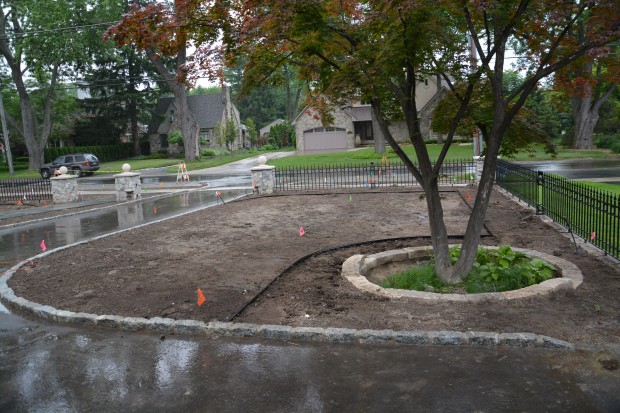 Once the grade was established, all of the beds to be landscaped were edged in aluminum edger strip. This insures the integrity of the bed lines, and more importantly, it keeps the lawn grass out of the borders. A landscape within reasonable maintenance limits is a landscape every client appreciates. Edging beds is not only a skill, it is a whomping lot of work. A landscape bed with sloppy edges has a sloppy look. Crisp edges and mowed grass can make the most weed stricken garden look better. An existing Japanese maple that had survived the construction was protected from the grade change with a stone well.
Once the grade was established, all of the beds to be landscaped were edged in aluminum edger strip. This insures the integrity of the bed lines, and more importantly, it keeps the lawn grass out of the borders. A landscape within reasonable maintenance limits is a landscape every client appreciates. Edging beds is not only a skill, it is a whomping lot of work. A landscape bed with sloppy edges has a sloppy look. Crisp edges and mowed grass can make the most weed stricken garden look better. An existing Japanese maple that had survived the construction was protected from the grade change with a stone well.
 Areas which would be planted with perennial material are treated differently than those for trees and shrubs. A tree which is properly sited for zone, existing soil and light will, given a little care, take hold and thrive. There will be no deadheading, or dividing. With any luck, that thriving will go on for many years. If you count out horseradish, and some of the big growing grasses, most perennials do not put down roots that deep. But I do like 16 inches of decent well drained soil, if I can get it. A garden grown on sand is easily to establish, and the devil to keep year after year. The gardens to be planted on this heavy clay soil may take some doing. More than likely, we will loose some plants. But once established, and top dressed every year with compost or ground hardwood bark, a garden in heavy soil will have a long and happy life.
Areas which would be planted with perennial material are treated differently than those for trees and shrubs. A tree which is properly sited for zone, existing soil and light will, given a little care, take hold and thrive. There will be no deadheading, or dividing. With any luck, that thriving will go on for many years. If you count out horseradish, and some of the big growing grasses, most perennials do not put down roots that deep. But I do like 16 inches of decent well drained soil, if I can get it. A garden grown on sand is easily to establish, and the devil to keep year after year. The gardens to be planted on this heavy clay soil may take some doing. More than likely, we will loose some plants. But once established, and top dressed every year with compost or ground hardwood bark, a garden in heavy soil will have a long and happy life.
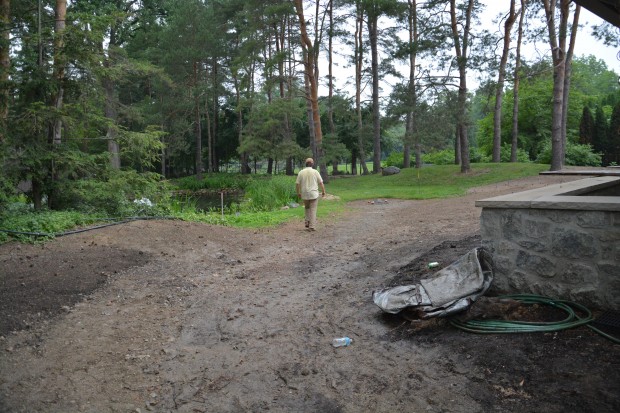 Establishing the proper grade in the back yard took some finesse. Of course, matching the new grade to the old would be ideal. But the new house and walks have created drainage issues which never existed before. The most likely spot for water to pool is dead ahead. The contractor had run several large storm drains to exactly this spot. The last part of the grading would be to lower the grade from the stone walk yet to come to the pond. The big idea here was to plan for surface water to have an unobstructed path to the pond. What could be better than keeping the level of the pond up with rain water?
Establishing the proper grade in the back yard took some finesse. Of course, matching the new grade to the old would be ideal. But the new house and walks have created drainage issues which never existed before. The most likely spot for water to pool is dead ahead. The contractor had run several large storm drains to exactly this spot. The last part of the grading would be to lower the grade from the stone walk yet to come to the pond. The big idea here was to plan for surface water to have an unobstructed path to the pond. What could be better than keeping the level of the pond up with rain water?
A Landscape For A Gardener: The Structure
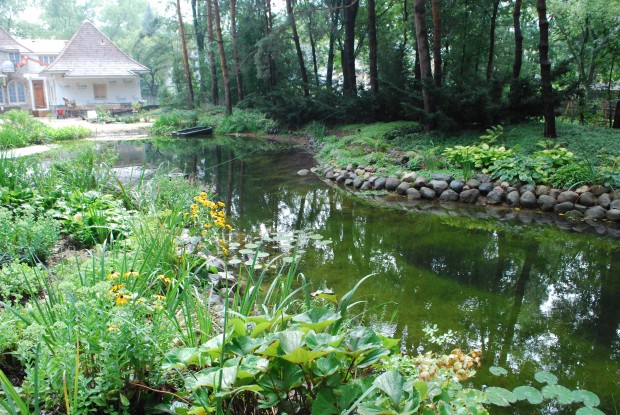 This landscape project took a little better than two years to build, from start to finish. We planted new pots on the rear terrace for summer, in mid August. A client who is an avid gardener and naturalist with a large piece of property decided to take down her home of many years, and build anew. The building project had already been going on for better than a year before my first visit. The west half of the property, dominated by a huge pond and barn, was untouched by the construction. The pond was full of water lilies, and skirted by all kinds of bog loving plants. Old scotch pines, and densiformis yews of considerable size and age provided lots in the way of screening of the neighboring properties.
This landscape project took a little better than two years to build, from start to finish. We planted new pots on the rear terrace for summer, in mid August. A client who is an avid gardener and naturalist with a large piece of property decided to take down her home of many years, and build anew. The building project had already been going on for better than a year before my first visit. The west half of the property, dominated by a huge pond and barn, was untouched by the construction. The pond was full of water lilies, and skirted by all kinds of bog loving plants. Old scotch pines, and densiformis yews of considerable size and age provided lots in the way of screening of the neighboring properties. 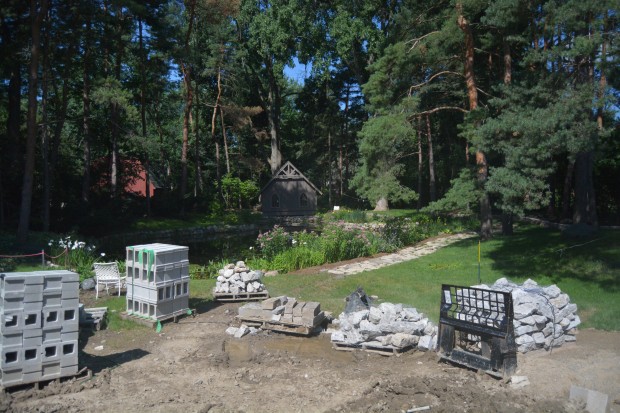
I never saw the original house and garden. Judging by what was left intact, it must have been lovely. Lots of plants had been heeled in as far away from the construction as possible. Discussions with my client confirmed her knowledge and interest in horticulture. Her keen interest in the landscape is every designer’s dream – a knowledgeable client with lots to contribute to the process. The old and the new would have to meld seamlessly. Fortunately we had plenty of time before we would put a shovel to the ground.
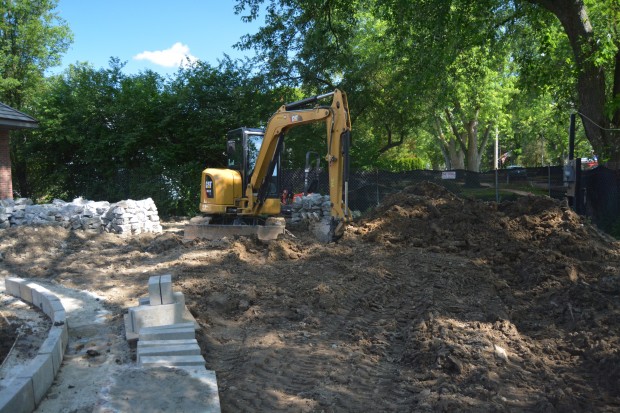 My first visit took place at that moment in the construction when every square foot was occupied by building materials, mud, machines, and mountains of unwanted dirt. It was very hard to imagine the landscape at this point, there was still so much work to do. It takes a certain courage and calm to take apart an established landscape in anticipation of a new house to be built. All of the hard structures would have to come first. Once the house is out of the ground, that elevation sets the grades for everything else-the driveway, the walkways, terraces, and in this case, a fountain and a pool. All of these architectural elements would dictate the tone, tenor, and placement of the landscape elements.. It was time for the first round of landscape design drawings.
My first visit took place at that moment in the construction when every square foot was occupied by building materials, mud, machines, and mountains of unwanted dirt. It was very hard to imagine the landscape at this point, there was still so much work to do. It takes a certain courage and calm to take apart an established landscape in anticipation of a new house to be built. All of the hard structures would have to come first. Once the house is out of the ground, that elevation sets the grades for everything else-the driveway, the walkways, terraces, and in this case, a fountain and a pool. All of these architectural elements would dictate the tone, tenor, and placement of the landscape elements.. It was time for the first round of landscape design drawings.
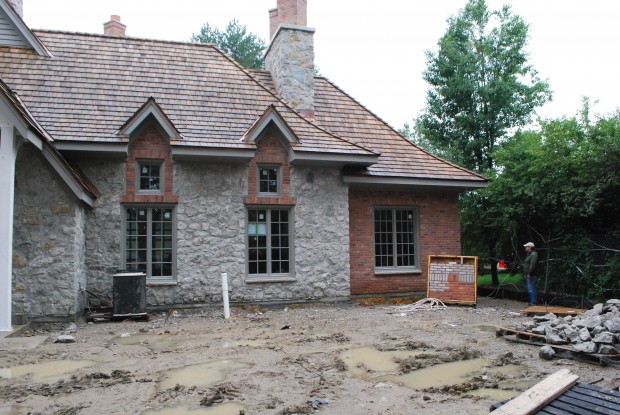
The house was in the later stages of construction. The walls were up – some stone, and some brick. A sample of the brick color and pattern, still in the front yard. Most of the windows had been installed. The lion’s share of the work was going on inside. Pallets of the remains of the building of the stone walls-still in the front yard. Also visible here, a temporary air conditioning unit. The months of machines and men going back and forth across the dirt had compacted the soil, squeezing just about every last bit of air out of the soil. Even a moderate rain would produce puddles that would not drain. There would be drains installed by the contractor, and more drains later, by us.
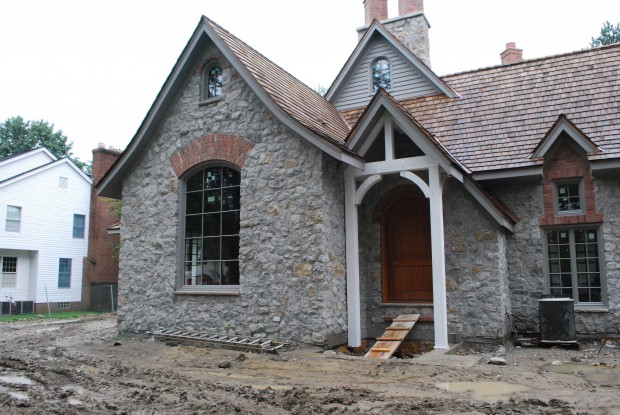 There was much discussion between my clients, their architect and I regarding the location and size of the driveway and walkways – all of it good. Many of the decisions about the pool, the pool deck, and pergolas had already been made. Any client knows more about how they want to live than anyone else. They were keen for a low wall opposite the front door, the interior of which would have a fountain, and seating. I did a number of drawings of the possibilities. My primary contribution was to suggest a break in the wall to the north, which would permit easy access through from one side of the yard to the other.
There was much discussion between my clients, their architect and I regarding the location and size of the driveway and walkways – all of it good. Many of the decisions about the pool, the pool deck, and pergolas had already been made. Any client knows more about how they want to live than anyone else. They were keen for a low wall opposite the front door, the interior of which would have a fountain, and seating. I did a number of drawings of the possibilities. My primary contribution was to suggest a break in the wall to the north, which would permit easy access through from one side of the yard to the other.
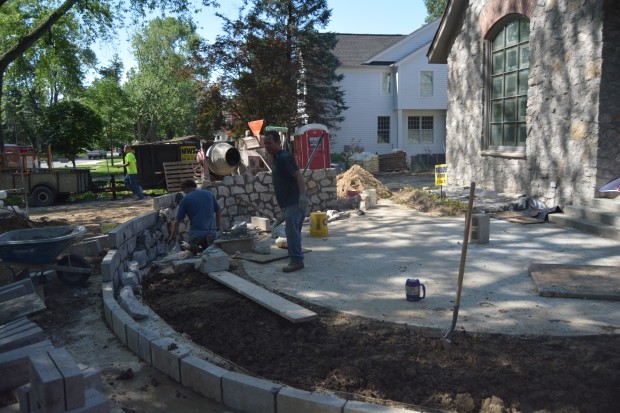 Though there was hope that all of the stonework would be done by late September of last year, it wasn’t. In August, it all seemed possible. But a very rainy fall and an early appearance of winter weather meant that the landscape construction would have to wait until spring. The last of the hard structures would be a series of low walls and gates in wrought iron.
Though there was hope that all of the stonework would be done by late September of last year, it wasn’t. In August, it all seemed possible. But a very rainy fall and an early appearance of winter weather meant that the landscape construction would have to wait until spring. The last of the hard structures would be a series of low walls and gates in wrought iron. 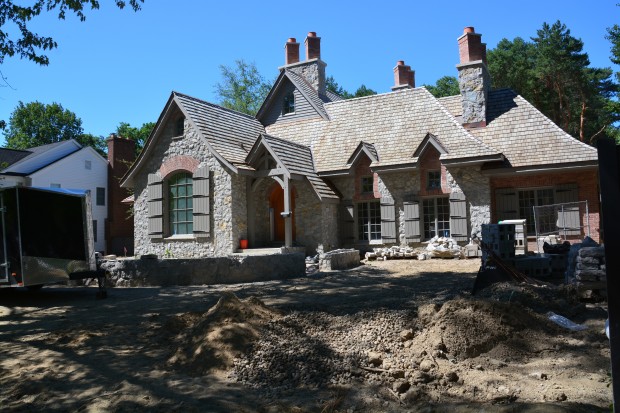 The luxury of a long project is the time there is to think through every decision. A low curved wall drawn on paper is a different matter than the reality of the wall. Having the time to react, and perhaps change direction can be good. Beyond that, construction delays are inevitable. Heavy rains do not deter any activity on the inside, but can create lengthy delays on the outside. Multiple contractors means the prospect of poor interface multiplies.
The luxury of a long project is the time there is to think through every decision. A low curved wall drawn on paper is a different matter than the reality of the wall. Having the time to react, and perhaps change direction can be good. Beyond that, construction delays are inevitable. Heavy rains do not deter any activity on the inside, but can create lengthy delays on the outside. Multiple contractors means the prospect of poor interface multiplies.
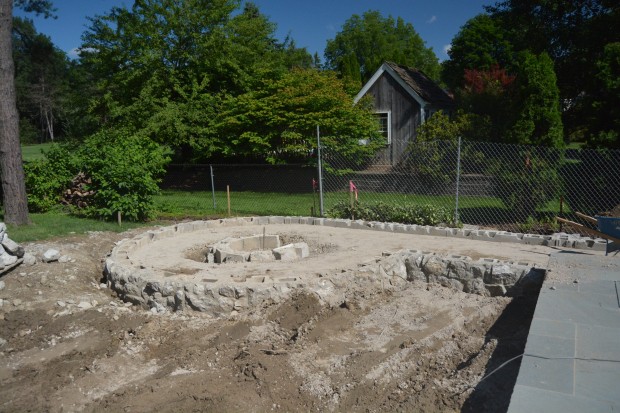 One later addition – a fire pit. Adding a structure such as this in a landscape renovation happens all the time. But for a new house, waiting for all of the hard structures to be built before the installation of the landscape helps insure a a look that is deliberate and all of a piece. Hard structures can create issues with drainage. No landscape with thrive, planted in soil that cannot or will not drain. Taking time with this now means fewer problems getting a landscape to establish later on.
One later addition – a fire pit. Adding a structure such as this in a landscape renovation happens all the time. But for a new house, waiting for all of the hard structures to be built before the installation of the landscape helps insure a a look that is deliberate and all of a piece. Hard structures can create issues with drainage. No landscape with thrive, planted in soil that cannot or will not drain. Taking time with this now means fewer problems getting a landscape to establish later on.
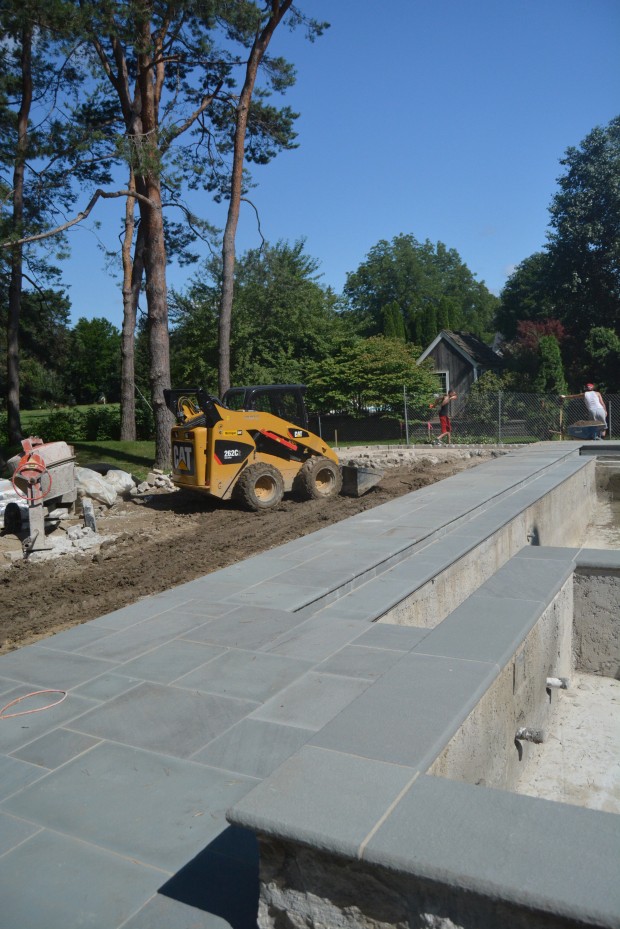 Nonetheless, I was looking forward to that moment when we could begin dealing with the dirt.
Nonetheless, I was looking forward to that moment when we could begin dealing with the dirt.

